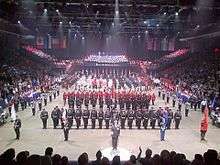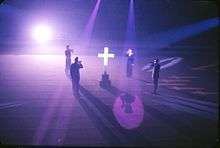Military tattoo
A tattoo is a military performance of music or display of armed forces in general. The term comes from the early 17th century Dutch phrase doe den tap toe ("turn off the tap"), a signal sounded by drummers or trumpeters to instruct innkeepers near military garrisons to stop serving beer and for soldiers to return to their barracks.
The tattoo was originally a form of military music, but the practice has evolved into more elaborate shows involving theatrics and musical performances. It is also used to designate military exhibitions such as the Royal International Air Tattoo.
Etymology
The term dates from around 1600 during the Thirty Years' War in the Low Countries (Belgium and the Netherlands). The Dutch fortresses were garrisoned with mercenary troops that were under federal command since 1594. The Dutch States Army had become a federal army, consisting mostly of Scottish, English, German and Swiss mercenaries, but commanded by a Dutch officer corps. Drummers from the garrison were sent out into the towns at 21:30 hrs (9:30PM) each evening to inform the soldiers that it was time to return to barracks. The process was known as doe den tap toe (Dutch for "turn off the tap"), an instruction to innkeepers to stop serving beer and send the soldiers home for the night. The drummers continued to play until the curfew at 22:00 hrs (10:00PM). Tattoo, earlier tap-too and taptoo, are alterations of the Dutch words tap toe which have the same meaning.Taptoo was the earlier used alteration of the phrase and was used in George Washington's papers in which he said:"In future the Reveille will beat at day-break; the troop at 8 in the morning; the retreat at sunset and taptoo at nine o'Clock in the evening."
.jpg)
Over the years, the process became more of a show and often included the playing of the first post at 21:30 hrs and the last post at 22:00. Bands and displays were included and shows were often conducted by floodlight or searchlight. Tattoos were commonplace in the late 19th century with most military and garrison towns putting on some kind of show or entertainment during the summer months. Between the First World War and the Second World War elaborate tattoos were held in many towns, with the largest in Aldershot, England.
Notable examples
Europe
One of the best known tattoos is held on the Esplanade in front of Edinburgh Castle each August as part of the annual Edinburgh Festival. The Royal Edinburgh Military Tattoo was first staged in 1950; it combines the traditional sounds of the bagpipes and drums with the modern aspects of the armed forces. In 2008, the Windsor Castle Royal Tattoo was launched, and held in the private grounds of Windsor Castle by permission of HM The Queen. The event's proceeds went to the Royal British Legion to help support recently returned troops from battle.
Another well-known tattoo was the Royal Tournament which was held annually in London from 1880 to 1999. The last producer of the Royal Tournament was Major Sir Michael Parker. The British Military Tournament, its successor, was established in 2010 at the former venue of the Royal Tournament, Earl's Court, lasting till 2013. Another UK tattoo is the Birmingham Tattoo held annually at the National Indoor Arena in November, which has been attracting audiences to Birmingham since 1989.
The Royal International Air Tattoo is the world's largest military airshow, held annually at RAF Fairford in Gloucestershire in aid of the RAF Charitable Trust.
The Norwegian Military Tattoo is internationally famous for its quality and streamlined production. It has been held every second year since 1994 in the capital of Norway, Oslo. Since 1996 the shows have been presented indoors - in the Oslo Spektrum which is "tailor-made" for this kind of event.
Russia have recently started the annual "Spasskaya Bashnya" (Russian for Spasskaya Tower) international military tattoo in Moscow (with Valery Khalilov as executive producer). Its Russian name came from the name of the location where it is performed (at the Red Square's "Saviour Tower"). Although it is commonly referred to as "Spasskaya Bashnya Military Tattoo", it's actual English name is "International Military Music Festival", and has been held since 2009. Its latest edition will be held in September 2016, and the tattoo forms part of the Moscow city's birthday celebrations.
Germany sports a huge number of such events with Bremen, Hamburg, Dresden and Berlin holding annual tattoos involving the Bundeswehr, civil bands and international bands invited.
The Basel Tattoo (Switzerland) was started in 2006 by the local Top Secret Drum Corps. It has grown to be the world's second largest military tattoo in terms of performers and budget after the Edinburgh Military Tattoo.
The annual Hamina Tattoo in Finland is the official military tattoo event of the Finnish Defense Forces.
North America

Canada's Royal Nova Scotia International Tattoo is the largest annual indoor tattoo, each year featuring over 2000 performers from around the world. The tattoo has been produced since 1979 by Colonel Ian Fraser, who also produced the 1967 Canadian Armed Forces Centennial Tattoo (see below), the world's largest travelling show. Through the course of his career Fraser has produced and / or directed more than 1000 international tattoo productions across the globe.
The Royal Nova Scotia International Tattoo is unique in that it is a full theatrical production, comprising costume designers, props designers, full wardrobe staff, and is presented as 'theatre in the round'. The show is intensely rehearsed over a two-week period and is a wholly combined military and civilian production. The Nova Scotia Tattoo was the first tattoo to receive royal designation on the occasion of Her Majesty Queen Elizabeth II's 80th Birthday in 2006[1]
The largest tattoo in the United States is the Virginia International Tattoo, held every year in Norfolk, Virginia. Over 850 performers play traditional music and many international acts join every branch of the Armed Forces.
The United States Air Force holds tattoos for many different events and celebrations, like base openings and closers, and special events like the 21st Annual Langley Tattoo.[2] The Air Force's largest tattoo is held the last Friday of June each year at Wright-Patterson AFB, Ohio. The 2010 tattoo there drew an estimated 75,000 people and featured the rock group .38 Special. The 2011 event featured aircraft flyovers and music by country group Lonestar.

The Canadian Armed Forces Tattoo 1967 was the largest mobile tattoo in history performing 155 performances in 47 cities from coast to coast from the end of March to the middle of October 1967. Tattoo '67 was a completely a military production involving over 1700 personnel from the Canadian Army, Navy and Air Force. The first leg of the tour involved transporting two shows across Canada by rail. The second phase saw "the show" performed in stadiums in major cities including a week long run in Montreal, Quebec during EXPO 67. The third phase was a tour of East Coast cities and Quebec performing in arenas. The show received rave reviews and standing ovations and was called upon by the press to become an annual event and to have it tour not only throughout the United States but Europe as well but with the last performance on October 11, 1967 at Shawinigan, Quebec, the Tattoo was mothballed. Eventually all the costumes and uniforms were sold off to museums or private collectors and the show that was hailed as "the greatest single presentation during Centennial year" has never been produced since. The producer of Tattoo 1967, Colonel Ian Fraser also produced the Royal Nova Scotia International Tattoo noted above.
The annual Fort Henry Tattoo is held each July at Fort Henry[3] in Kingston, Ontario. The event combines military drill, with an assortment of musical acts from across Canada, and is capped off with a fireworks display at the end of the evening. It is one of the largest annual events held at the National Historic Site.
The now-defunct Quebec City International Festival of Military Bands, and its Quebec City Military Tattoo, took place in August between 1998 and 2013.
Asia
Since 1978 the Japan Self-Defense Forces Marching Festival has been the country's military tattoo, featuring guest bands from the Asia-Pacific and the bands of the service branches of the Japan Self-Defense Forces, plus traditional drum teams from the JSDF. Held in the Nippon Budokan in Tokyo every November since its first edition, it is also Asia's oldest.
The International Military Heritage Festival, organized by the Republic of Korea Armed Forces, is the national military tattoo of South Korea. Held every April in Seoul, it consists of performances from the military bands and drill teams of the ROKAF.
Hong Kong held international military tattoo in 2012 and 2017, on the occasion of the 15th and the 20th anniversary of the return of Hong Kong to The People's Republic of China. The Military Band of the People's Liberation Army of China and Hong Kong Police Force had essential roles to play. The performances also included military bands from Mongolia, The Netherlands, Russia, The United Kingdom (Scotland), and The United States.
See also
References
External links
- Tattoo 1967
- The Aldershot Tattoo
- The Royal Tournament Website
- The short film STAFF FILM REPORT 66-29A (1966) is available for free download at the Internet Archive
- Air Force Materiel Command Freedom's Call Tattoo